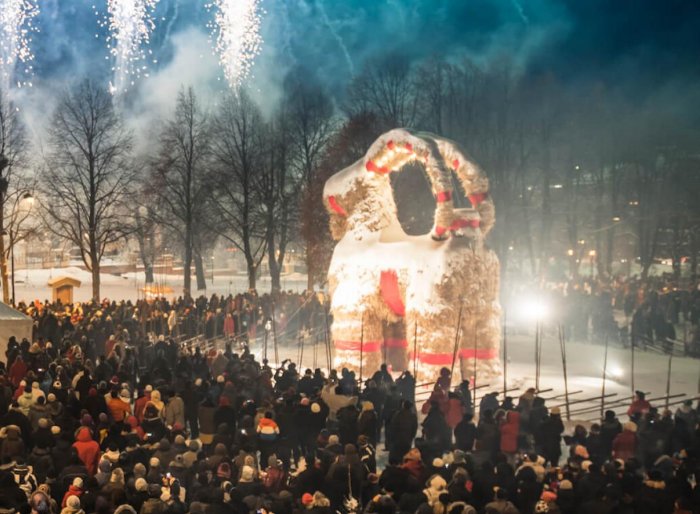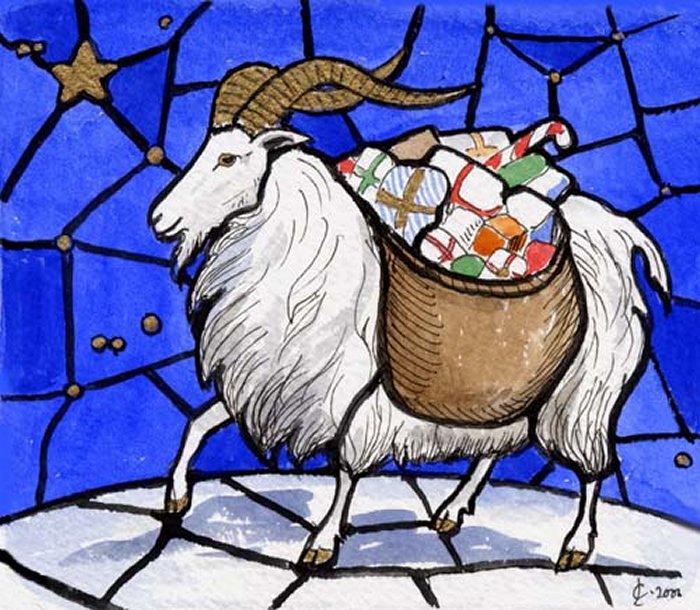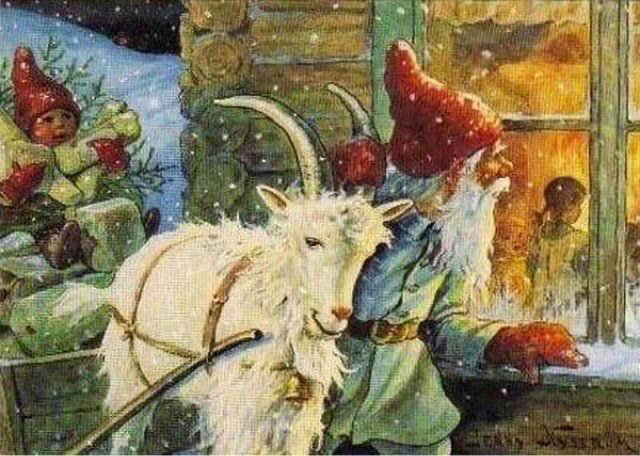Yule Goat Is A Scandinavian Christmas Tradition Based On Norse Legends And Worship Of God Thor
Ellen Lloyd - AncientPages.com -If you ever visit Sweden during Christmas, make sure to go to the city of Gävle, where you can see a colossal goat made of straw standing at Slottstorget (Castle Square).
Yule Goat (Gävlebocken) in Gävle, Sweden. Image credit: Visit Gävle
The giant goat is erected yearly at the beginning of Advent over two days. It's an annual Christmas tradition based on Norse legends and worship of the Thunder God Thor.
According to the Guinness Book of World Records, at 49 feet tall to the upper curve of its horns, the 1993 version of the Gävle goat holds the record for the world's giant straw goat.
The history of the Yule Goat goes back several thousands of years, and many ancient myths and legends show how important this animal was to our ancestors.
In some Norse myths, God Thor was said to be riding a flying chariot drawn by two goats.
The Yule Goat is one of the oldest Scandinavian Yule symbols and traditions.
It was believed that the goats Tanngrisnir ("Gap-tooth") and Tanngnjóstr ("Tooth-grinder"), who pulled Thor's chariot, provided food for the God and his friends.
People in Scandinavia were just some who understood the value of the Yule Goat. Slavic mythology shows us that a white goat represents the Sun God Dazbog. Koliada (Yule), an ancient pre-Christian Slavic winter festival later incorporated into Christmas, started to honor the God of the fertile Sun and the harvest. The Koliada festivals always had a person dressed as a goat, often demanding offerings in the form of presents.
So, the Yule Goat's origins go back to ancient Pagan festivals, and the celebration and beliefs have changed much over the years.
In ancient times, people in Sweden believed that the Yule Goat was an invisible spirit that would appear sometime before Christmas to check if the Christmas preparations had been done correctly.
God Thor and his two goats. Painting by Max Friedrich Koch (1859 - 1930
There was a time when the Yule Goat was considered a demonic and frightening creature that roamed the countryside on the night of December 25, demanding food and frightening devout Christians. It changed with time, and the Yule Goat became a beloved being worshipped all across Scandinavia.
During the 19th century in Scandinavia, the Yule Goat received a similar role to Santa Claus. People dressed as the Christmas Yule Goat and traveled door to door, distributing small gifts to the families they visited.
In time, the role of holiday gift-giving passed to gnomelike, goat-riding Christmas elves called tomten (Sweden), Nissen (Norway), and tonttu (Finland), who delivered gifts to sleeping children like Santa Claus does today.
Variously known as a julbock (Sweden), julebukk (Norway), or olkipukki (Finland), the tradition of making straw goat ornaments during the Christmas season is still alive all across Scandinavia and Northern Europe. Yule goats range in size from tiny ones to tie on the Christmas Tree to the giant goat erected in Gävle.
Illustration by Jenny Nyström, Swedish artist.
The first Gävle Goat was put up on December 1, 1966. Unfortunately, in the last few years, the excellent straw goat has been repeatedly destroyed by vandals. It has been burned down several times, and today, many people feel the goat needs better protection. So, there are even safety cameras monitoring movements around the goat.
Fortunately, the fire station is near where the goat is erected, and, in most cases, they can extinguish the fire before the whole wooden structure is damaged.
Vandals may try to destroy the Yule Goat, but the fact remains that in Sweden, Norway, and Finland, the Yule Goat is as much a part of Christmas tradition as Santa Claus or Frosty the Snowman.
The Yule Goat is simply a significant Christmas symbol in Scandinavia.
Updated on December 1, 2023
Written by Ellen Lloyd – AncientPages.com
Copyright © AncientPages.com All rights reserved. This material may not be published, broadcast, rewritten or redistributed in whole or part without the express written permission of AncientPages.com
Expand for referencesMore From Ancient Pages
-
 On This Day In History: Great Sheffield Flood – Largest Man-Made Disaster Occurred In England – On Mar 11, 1864
News | Mar 11, 2017
On This Day In History: Great Sheffield Flood – Largest Man-Made Disaster Occurred In England – On Mar 11, 1864
News | Mar 11, 2017 -
 15,000-Year-Old Petroglyphs Discovered In The Gobi Desert May Be Evidence Ancient Turks Visited Mongolia – Expert Says
Archaeology | Apr 5, 2022
15,000-Year-Old Petroglyphs Discovered In The Gobi Desert May Be Evidence Ancient Turks Visited Mongolia – Expert Says
Archaeology | Apr 5, 2022 -
 Nerva: ‘Pater Patriae’ – Aging Roman Emperor Who Succeeded In Time Of Crisis
Featured Stories | Jan 3, 2020
Nerva: ‘Pater Patriae’ – Aging Roman Emperor Who Succeeded In Time Of Crisis
Featured Stories | Jan 3, 2020 -
 Coyote – Native American Trickster, Creator, And Sacred Animal Who Can Deceive But Also Give Wisdom
Featured Stories | Apr 28, 2017
Coyote – Native American Trickster, Creator, And Sacred Animal Who Can Deceive But Also Give Wisdom
Featured Stories | Apr 28, 2017 -
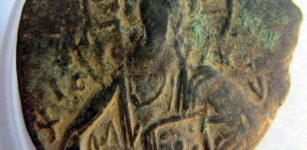 A 1,000-Year-Old Bronze Coin Accidentally Discovered By A Little Boy
Archaeology | Mar 12, 2020
A 1,000-Year-Old Bronze Coin Accidentally Discovered By A Little Boy
Archaeology | Mar 12, 2020 -
 On This Day In History: Franco-Mexican War – Mexico City Captured By French Troops – On June 7, 1863
News | Jun 7, 2016
On This Day In History: Franco-Mexican War – Mexico City Captured By French Troops – On June 7, 1863
News | Jun 7, 2016 -
 1,200-Year-Old Wari Temple Discovered In Peru
Archaeology | Feb 24, 2023
1,200-Year-Old Wari Temple Discovered In Peru
Archaeology | Feb 24, 2023 -
 Well-Known Powerful Yin Yang Symbol Dates Back To Ancient China
Ancient Symbols | Sep 23, 2016
Well-Known Powerful Yin Yang Symbol Dates Back To Ancient China
Ancient Symbols | Sep 23, 2016 -
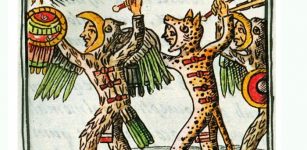 Florentine Codex: Remarkable Manuscripts About Life Of The Aztecs
Ancient History Facts | Nov 15, 2016
Florentine Codex: Remarkable Manuscripts About Life Of The Aztecs
Ancient History Facts | Nov 15, 2016 -
 Eastern Necropolis Of Ancient Thracian And Roman City Of Serdica – Unearthed
Archaeology | Apr 10, 2017
Eastern Necropolis Of Ancient Thracian And Roman City Of Serdica – Unearthed
Archaeology | Apr 10, 2017 -
 Anatolia’s Seyitömer Mound Was Inhabited In Bronze Age, Achaemenid, Hellenistic, And Roman Times
Archaeology | Aug 17, 2020
Anatolia’s Seyitömer Mound Was Inhabited In Bronze Age, Achaemenid, Hellenistic, And Roman Times
Archaeology | Aug 17, 2020 -
 Utiseta – Norse Vision Quest – Ancient Spiritual Tradition Of Northern Europe
Ancient Traditions And Customs | Oct 3, 2019
Utiseta – Norse Vision Quest – Ancient Spiritual Tradition Of Northern Europe
Ancient Traditions And Customs | Oct 3, 2019 -
 Ancient Cave Church Complex In Basarabi, Romania
Civilizations | Dec 11, 2018
Ancient Cave Church Complex In Basarabi, Romania
Civilizations | Dec 11, 2018 -
 Mummified Crocodiles Provide Insights Into Mummy-Making Over Time
Archaeology | Jan 19, 2023
Mummified Crocodiles Provide Insights Into Mummy-Making Over Time
Archaeology | Jan 19, 2023 -
 Struggle To Get Mail On Time Has Lasted More Than 5,000 Years – Part 3
Featured Stories | Aug 1, 2017
Struggle To Get Mail On Time Has Lasted More Than 5,000 Years – Part 3
Featured Stories | Aug 1, 2017 -
 What Was The Symbolism Behind Native American Feathers?
Ancient History Facts | Apr 21, 2017
What Was The Symbolism Behind Native American Feathers?
Ancient History Facts | Apr 21, 2017 -
 Unusual Grave Of The Trzciniec Culture Is An Archaeological Puzzle
Archaeology | Dec 23, 2019
Unusual Grave Of The Trzciniec Culture Is An Archaeological Puzzle
Archaeology | Dec 23, 2019 -
 Pyramid Of Unknown Ancient Egyptian Queen And Hundreds Of Mummies Discovered In Saqqara
Archaeology | Nov 17, 2022
Pyramid Of Unknown Ancient Egyptian Queen And Hundreds Of Mummies Discovered In Saqqara
Archaeology | Nov 17, 2022 -
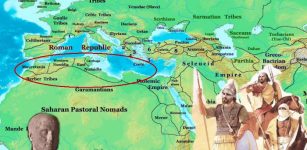 On This Day In History: Emperor Gordian II Loses The Battle Of Carthage – On Apr 12, 238 AD
News | Apr 12, 2016
On This Day In History: Emperor Gordian II Loses The Battle Of Carthage – On Apr 12, 238 AD
News | Apr 12, 2016 -
 Curious Bannerstones Used By Prehistoric Native Americans For Unknown Purpose
Artifacts | May 31, 2021
Curious Bannerstones Used By Prehistoric Native Americans For Unknown Purpose
Artifacts | May 31, 2021

